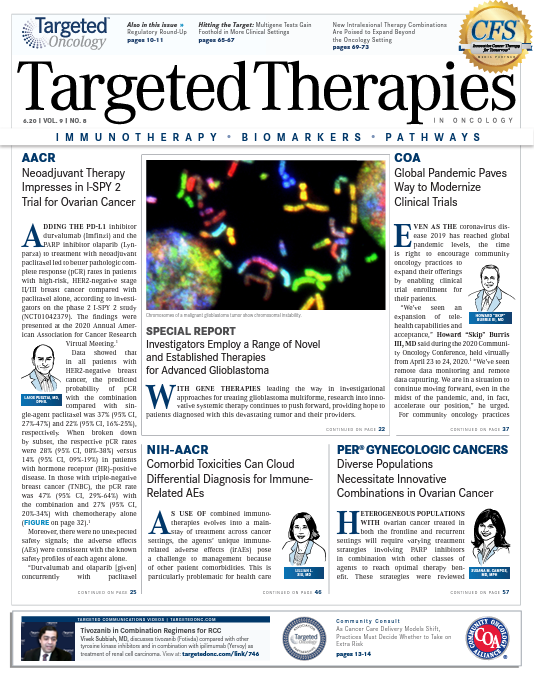Ease of Use With Subcutaneous Daratumumab Supplants the Intravenous Formulation as Standard of Care Across Settings in Myeloma
In an interview with Targeted Therapies in Oncology, C. Ola Landgren, MD, PhD, discussed how the availability of daratumumab by subcutaneous administration will affect clinical practice going forward.
C. Ola Landgren, MD, PhD

The role of daratumumab (Darzalex) in the setting of multiple myeloma continues to evolve, most recently with the approval of daratumumab and hyaluronidase-fihj (Darzalex Faspro), which allows subcutaneous dosing of the CD38-targeted monoclonal antibody.1
With several concluded and ongoing phase 3 trials for patients with newly diagnosed and relapsed/refractory disease, daratumumab persistently reestablishes itself in the multiple myeloma treatment paradigm, both as monotherapy and in combination with other agents in this setting. Initial FDA approval of the agent occurred in November of 2015, for the indication of relapsed/refractory myeloma.2 In mid-2019, daratumumab received FDA approval in combination with lenalidomide (Revlimid) and dexamethasone as upfront therapy for use in patients with newly diagnosed myeloma who are nontransplant candidates, based on data from the phase 3 MAIA trial (NCT02252172).3
In an interview with Targeted Therapies in Oncology (TTO), C. Ola Landgren, MD, PhD, chief of the Myeloma Service at Memorial Sloan Kettering Cancer Center in New York, New York, discussed how the availability of daratumumab by subcutaneous administration will affect clinical practice going forward.
TTO: Could you discuss the efficacy and tolerability of intravenous (IV) daratumumab versus the subcutaneous formulation?
Landgren: All the established combinations work well with the addition of daratumumab, and you don’t see any strong adverse events except for the fact that with the IV administration, around 50% of the patients have an infusion reaction. [Infusion-related reactions with] the subcutaneous administration occur in less than 10% of patients.
Daratumumab being approved for administration as a subcutaneous drug is a huge step forward for the myeloma field, [as it] gives every patient access to daratumumab. There had been some hesitation by smaller practices that don’t treat many patients [because] the administration of monoclonal antibodies as infusions took an extended window of time, at least with the f irst dose. That was a bit of a barrier, but once you got up and going, it could be done in a few hours or even by rapid infusions in 90 minutes. With the subcutaneous administration, you start off faster. It’s just an injection, or a 5-minute procedure. You still have to monitor the patient afterward, but the fact that it’s a quick injection is fantastic for patients. It makes it much more feasible for administration in [smaller] offices.
From the studies that have been presented so far, the efficacy seems to be virtually identical compared with the IV drug. These are single-drug studies comparing subcutaneous with IV administration. We don’t yet have a lot of data from combination studies, but there’s no reason to believe that it wouldn’t be the same [as that observed with monotherapy regimens].
It’s not yet fully known, but my prediction based on my clinical experience…is that premedication with steroids can probably be cut back [as well as] the antihistamine premedication. The overall experience with daratumumab will be even more gentle, beyond the fact that it’s now an injection because we can also cut back on the premedication. We will need more data to fully hammer this out, but that’s my prediction.
TTO: Will the subcutaneous dose reduce patient time in the office?
Landgren: The subcutaneous dose will definitely reduce patient time in the office, although we don’t know to what degree we need to monitor patients after the first dose with the subcutaneous drug. We don’t fully know what the time window should be for monitoring [patients for infusion-related reactions]. We could potentially have patients waiting in the building instead of sitting in the chemotherapy suite for hours, like we have done when we had given the IV infusion. I think we will learn as we go. To begin with, we will probably have the patient around for a few hours; then after the first cycle, it will probably be a short visit.
TTO: How will the availability of subcutaneous daratumumab have an impact on your treatment strategy?
Landgren: Access to a subcutaneous version will make daratumumab even more attractive for any indication. It could be partnered even more so with combination drugs in the upfront setting, given that the FDA and/or NCCN [National Comprehensive Cancer Network] Guidelines approve it. In the relapsed setting, I think it gives daratumumab a leg up compared with other drugs because it’s easy [to administer], well tolerated, and efficacious. I also think that the use of daratumumab as an extended-dosing regimen in the fashion of a maintenance therapy will probably become more and more popular. It’s not being developed as a maintenance drug, but I think it’s likely that daratumumab could take the role of a continued injection over time. We will see exactly where that’s going to land.
TTO: Which patients would you recommend subcutaneous daratumumab for?
Landgren: Being that it is FDA approved as a subcutaneous drug, in my mind, that indicates should immediately be implemented and replace the IV drug. It gives us access to a good drug for more patients because it’s easier to give and we can give it anywhere. You don’t have the long infusion time in the beginning, which we used to have with the IV formulation.
TTO: How would you advise community oncologists on the use of subcutaneous daratumumab versus IV formulation in terms of the dosing and administration schedule?
Landgren: The administration schedule for the subcutaneous version of daratumumab is the same as the IV administration. Per the FDA label, it’s once a week for 8 doses, then every other week for 8 doses, and then once per month every 28 days. The subcutaneous administration is a fixed dose. The IV dose is 16 mg/kg body weight.4,5
References
- FDA approves daratumumab and hyaluronidase-fihj for multiple myeloma. US Food & Drug Administration. Updated May 1, 2020. Accessed May 14, 2020. https://bit.ly/35YbwDy
- Genmab announces US FDA approval of Darzalex (daratumumab) for multiple myeloma and updates financial guidelines. News release. Genmab A/S; November 16, 2015. Accessed May 14, 2020. https://bit.ly/3bxapMj
- FDA approves daratumumab for multiple myeloma ineligible for autologous stem cell transplant. US Food & Drug Administration. Updated June 28, 2019. Accessed May 14, 2020. https://bit.ly/2Z1BuVg
- Darzalex. Prescribing information. Janssen Biotech, Inc; 2015. Accessed May 14, 2020. https://bit.ly/2Z1CicK
- Darzalex. Prescribing information. Janssen Biotech, Inc; 2020. Accessed May 14, 2020. https://bit.ly/2WRW3AW

Gasparetto Explains Rationale for Quadruplet Front Line in Transplant-Ineligible Myeloma
February 22nd 2025In a Community Case Forum in partnership with the North Carolina Oncology Association, Cristina Gasparetto, MD, discussed the CEPHEUS, IMROZ, and BENEFIT trials of treatment for transplant-ineligible newly diagnosed multiple myeloma.
Read More
Key Trials From ASH 2024 Impact Treatment for Plasma Cell Disorders Going Forward
February 20th 2025Peers & Perspectives in Oncology editorial board member Marc J. Braunstein, MD, PhD, FACP, discussed the significant advancements in multiple myeloma treatment at the 2024 ASH Annual Meeting and Exposition.
Read More